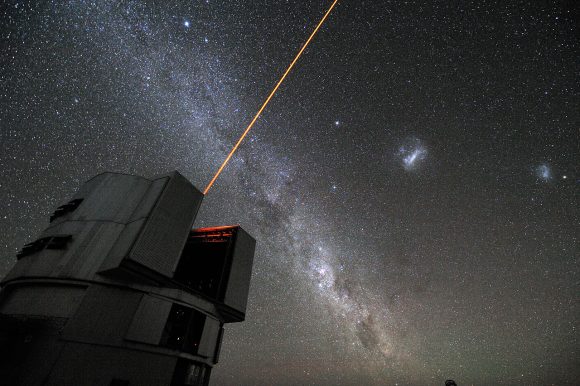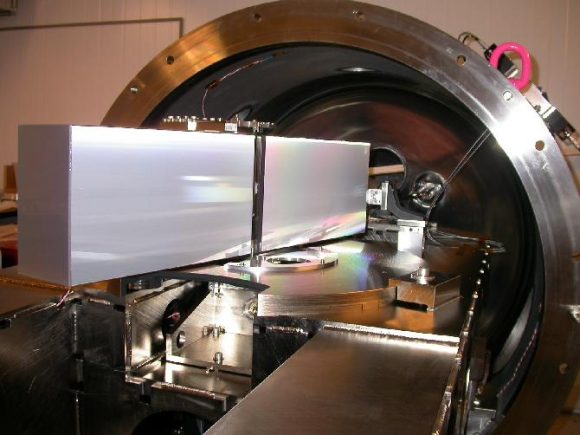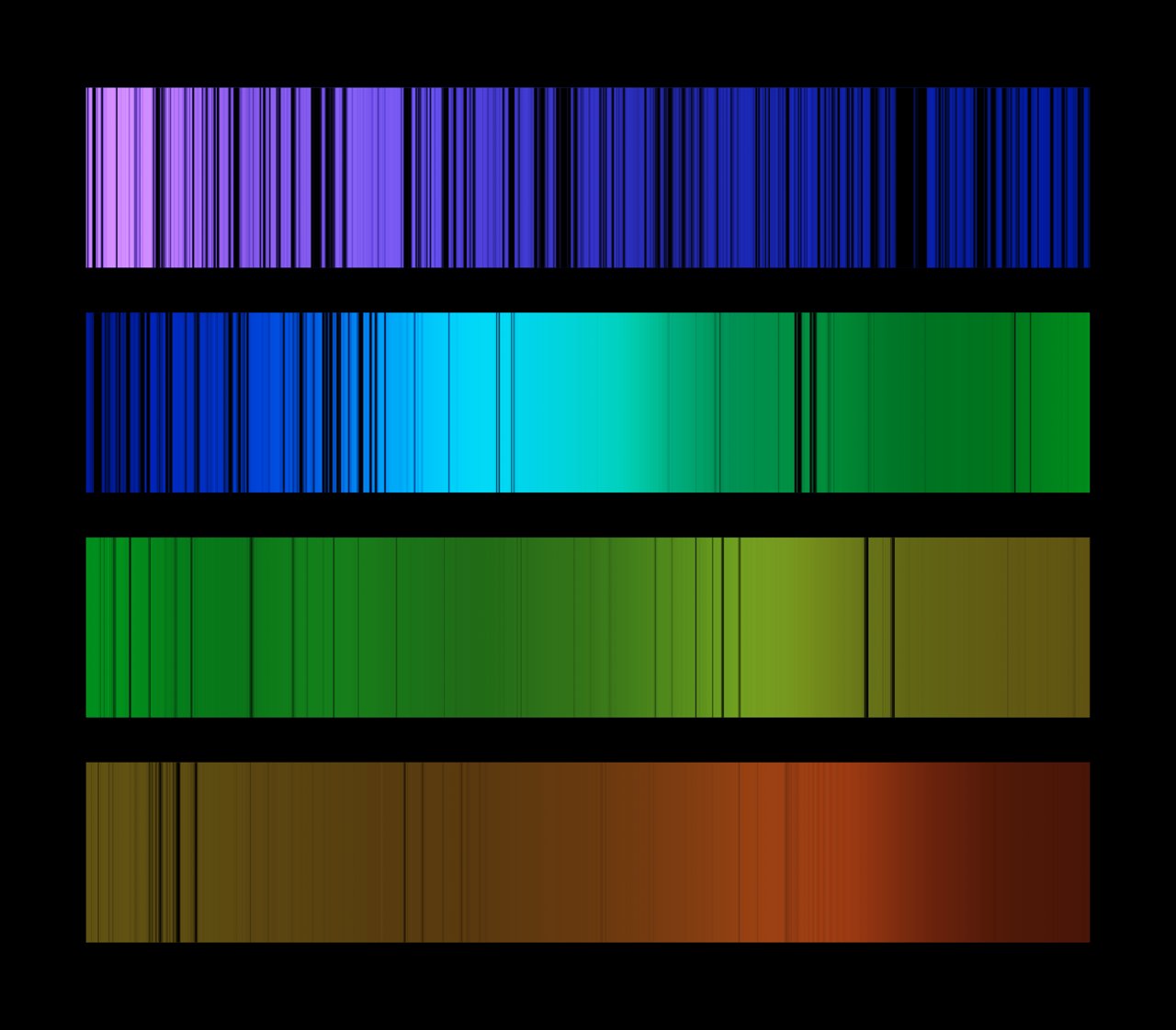Back in November, a team of researchers from the Swinburne University of Technology and the University of Cambridge published some very interesting findings about a galaxy located about 8 billion light years away. Using the La Silla Observatory’s Very Large Telescope (VLT), they examined the light coming from the supermassive black hole (SMBH) at its center.
In so doing, they were able to determine that the electromagnetic energy coming from this distant galaxy was the same as what we observe here in the Milky Way. This showed that a fundamental force of the Universe (electromagnetism) is constant over time. And on Monday, Dec. 4th, the ESO followed-up on this historic find by releasing the color spectrum readings of this distant galaxy – known as HE 0940-1050.
To recap, most large galaxies in the Universe have SMBHs at their center. These huge black holes are known for consuming the matter that orbits all around them, expelling tremendous amounts of radio, microwave, infrared, optical, ultra-violet (UV), X-ray and gamma ray energy in the process. Because of this, they are some of the brightest objects in the known Universe, and are visible even from billions of light years away.

Artist’s interpretation of ULAS J1120+0641, a very distant quasar.
Credit: ESO/M. Kornmesser
But because of their distance, the energy which they emit has to pass through the intergalactic medium, where it comes into contact with incredible amount of matter. While most of this consists of hydrogen and helium, there are trace amounts of other elements as well. These absorb much of the light that travels between distant galaxies and us, and the absorption lines this creates can tell us of lot about the kinds of elements that are out there.
At the same time, studying the absorption lines produced by light passing through space can tell us how much light was removed from the original quasar spectrum. Using the Ultraviolet and Visual Echelle Spectrograph (UVES) instrument aboard the VLT, the Swinburne and Cambridge team were able to do just that, thus sneaking a peak at the “fingerprints of the early Universe“.
What they found was that the energy coming from HE 0940-1050 was very similar to that observed in the Milky Way galaxy. Basically, they obtained proof that electromagnetic energy is consistent over time, something which was previously a mystery to scientists. As they state in their study, which was published in the Monthly Notices of the Royal Astronomical Society:
“The Standard Model of particle physics is incomplete because it cannot explain the values of fundamental constants, or predict their dependence on parameters such as time and space. Therefore, without a theory that is able to properly explain these numbers, their constancy can only be probed by measuring them in different places, times and conditions. Furthermore, many theories which attempt to unify gravity with the other three forces of nature invoke fundamental constants that are varying.“

Since it is 8 billion light years away, and its strong intervening metal-absorption-line system, probing the electromagnetic spectrum being put out by HE 0940-1050 central quasar – not to mention the ability to correct for all the light that was absorbed by the intervening intergalactic medium – provided a unique opportunity to precisely measure how this fundamental force can vary over a very long period of time.
On top of that, the spectral information they obtained happened to be of the highest quality ever observed from a quasar. As they further indicated in their study:
“The largest systematic error in all (but one) previous similar measurements, including the large samples, was long-range distortions in the wavelength calibration. These would add a ?2 ppm systematic error to our measurement and up to ?10 ppm to other measurements using Mg and Fe transitions.”
However, the team corrected for this by comparing the UVES spectra to well-calibrated spectra obtained from the High Accuracy Radial velocity Planet Searcher (HARPS) – which is also located at the at the La Silla Observatory. By combining these readings, they were left with a residual systematic uncertainty of just 0.59 ppm, the lowest margin of error from any spectrographic survey to date.

This is exciting news, and for more reasons that one. On the one hand, precise measurements of distant galaxies allow us to test some of the most tricky aspects of our current cosmological models. On the other, determining that electromagnetism behaves in a consistent way over time is a major find, largely because it is responsible for such much of what goes on in our daily lives.
But perhaps most importantly of all, understanding how a fundamental force like electromagnetism behaves across time and space is intrinsic to finding out how it – as well as weak and strong nuclear force – unifies with gravity. This too has been a preoccupation of scientists, who are still at a loss when it comes to explaining how the laws governing particles interactions (i.e. quantum theory) unify with explanations of how gravity works (i.e general relativity).
By finding measurements of how these forces operate that are not varying could help in creating a working Grand Unifying Theory (GUT). One step closer to truly understanding how the Universe works!
Further Reading: ESO


Amazing instruments!. I guess they are trying to see if the constants are time and space invariant. They are trying to apply the same invariant or symmetric rules for the constants of nature just like the laws of nature. As for example you would expect the laws of physics to be the same in a different part of the universe as here on earth and the same at different times. That was Emmy Noether ( stupid spell checker thinks I spelled Emmy’s last name wrong. What a dumbass considering Emmy proved the theorem that shows physical laws are invariant in space and time which is equivalent to the conservation of energy and the conservation of momentum. She use mathematical symmetry to derive physical laws. ) So are we asking if the constants are invariant? Interesting puzzle. I wonder if there is an equivalent of Heisenberg’s uncertainty principle with mass and location interchanged with physical law and constant of nature. That would be a real pisser wouldn’t it?
Excellent presentation which focuses on the real driving force for observable structure and function of the universe.
In view of much recent radio telescope data that supports the models presented by the electric universe theory., these theories should be thoroughly revisited by the mainstream astrophysical comunity. Documentation of intergalactic flows of charged particles (currents) suggests that Donald Scott’s published work “Modeling Birkeland Currents” should be carefully studied. The findings of massive magnetic fields surrounding galaxies, galactic centers (“black holes”) and stars (i.e. the sun) strongly suggest that electromagnetism plays a critical role in the formation of these bodies.
The failure to document dark matter and dark energy after 30 years and billions of dollars emphasizes the need to evaluate other known forces that could account for galaxy formation. Electromagnetic models have observational and experimental support showing they accurately predict how stars and galaxies form. Current solar missions (IBEX, etc.) have given us excellent data on the structure of the sun (and therefore stars). The electomagnetic model of the sun has conformed nicely with these findings. It appears that the “photospheric granules” that compose the surface are in fact anode tufts. This information was experimentally confirmed by plasma physicists in the Safire Project and eloquently presented by Donald Scott.
Wal Thornhill’s presentation “The Long Road to understanding Gravity” makes a sound case that gravity is really a weak form of electromagnetism. It is starting to be more likely that there is only one true force….electromagnetism. This would be a rational starting point to develop a true grand unified theory.
Wouldn’t it be simple if the GUT was just a simple Calculus equation that everybody knew but just didn’t give enough consideration? Just got to determine if time is a dimension of the Universe or a Property.